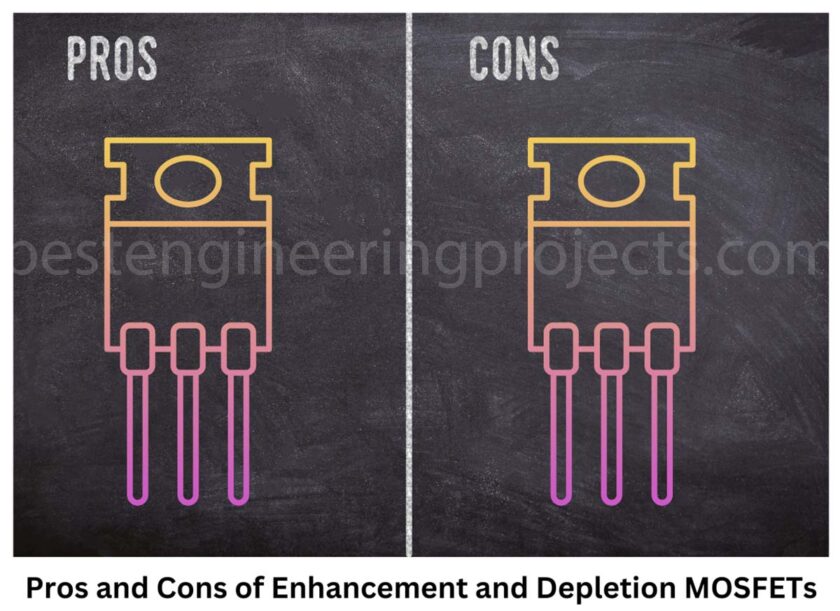MOSFETs, or Metal-Oxide-Semiconductor Field-Effect Transistors, are widely used in many electronic applications because of their practical switching and amplifying functions. Two kinds of MOSFETs are used: the Enhancement MOSFET and the Depletion MOSFET. Each type differs in characteristics, advantages, and disadvantages. Here is a short overview to compare the pros and cons of enhancement and depletion MOSFETs to decide which will suit your application.
Enhancement MOSFETs
Starting from The enhancement, MOSFETs are the most applied type in today’s electronics. They are “normally off” when V_GS = 0, and thus, no current flows through the drain unless the gate voltage exceeds a threshold value.
Pros of Enhancement MOSFETs
- Low Power Consumption: Enhancement MOSFETs consume a meager power in the off state; thus, they are suitable for energy-efficient designs.
- High Input Impedance: Their extremely high input impedance does not load the driving circuit, and these MOSFETs are well-suited for amplification in several applications and signal isolation.
- Fast switching speed: They can provide high-speed switching, which becomes irreplaceable in applications requiring high frequency, such as power supplies, motor controllers, and RF circuits.
- Power Control Efficiency: Enhancement MOSFETs operate at high current and voltage with a minimum loss. Thus, they are used in power electronics, such as switching regulators.
- Smaller in Size: Due to their structure, they are also smaller than other kinds of transistors, which is an advantage in integrated circuits.
- Thermal Stability: They have good thermal stability compared with BJTs; hence, these are more reliable at higher temperatures.
- Low On-Resistance: When fully turned on, enhancement MOSFETs have low on-resistance; therefore, there will be lower power dissipation during operation.
Cons of Enhancement MOSFETs
- Voltage-Driven: They require sufficiently high gate voltage for turn-on, which introduces complexity in the design of gate-driving circuits.
- Gate-Source Voltage Sensitivity: The enhancement types of MOSFETs are susceptible to static electricity or voltage spikes and may readily cause damage to the device if that is not suitably protected.
- Nonlinear Operation: Their nonlinear characteristic makes them less perfect in certain instances for an accurate analog amplification.
- Conduction of Body Diode During Reverse Current: Internal body diodes can conduct in the reverse direction. Additional protection components are, therefore, necessary especially when the circuit configuration calls for it.
- Variation of Threshold Voltage: Of course, variation in threshold voltage could all lead to some kind of unpredictable switching action, especially were this applied to some of the most sensitive applications.
- High Gate Capacitance: The gate capacitance may be high in big MOSFETs, and thus, more current is needed to switch them quickly. This complicates the high-frequency design.
Depletion MOSFETs
Depletion MOSFETs are the other extreme and are “normally on” when the V_GS is zero. To turn them off, you need to apply a reverse voltage to the gate, and in that sense, they behave more like a regular JFET.
Pros of Depletion MOSFETs:
- Normally ON State: The depletion MOSFETs normally conduct and are thus useful in fail-safe circuits or in any other applications that require a default power-on state.
- Linear Amplification: Depletion MOSFETs present superior linearity in analogue circuits; for this reason, they are suitable for amplification and other analogue signal-processing jobs.
- High Input Impedance: Similar to enhancement MOSFETs, the depletion types also offer very high input impedance, which is ideal for signal isolation and amplification.
- Less Switching Loss: Depletion MOSFETs can decrease switching losses, especially in low-power circuits, since they require no continuous gate drive to remain in the ‘on’ state.
- Fast Switching Time: Other positive features of depletion MOSFETs are that they support fast switching time and hence are suitable for radio-frequency applications.
- Fail-Safe Operation: Intrinsic nature makes them very suitable for fail-safe applications, and therefore in case of loss of the control signal, the device is operational.
Cons of Depletion MOSFET
- Limited Availability: The depletion type of MOSFETs is less available and, hence, challenging to source compared to their enhancement counterpart; thus, it is less popular in consumer electronics.
- Normally On Can Be a Disadvantage: In most circuits, a normally-on device is not desirable, and in such cases, depletion MOSFETs require additional Circuitry to turn them off, increasing complexity.
- Requirements of Gate Drive: On the other hand, depletion MOSFETs require a negative gate voltage with respect to the source potential for the n-channel and a positive one for the p-channel to turn them off. This complicates the gate drive’s operating circuit.
- Limited Application in Digital Circuits: The application of depletion MOSFET in digital circuits is limited where the devices operate entirely on or off.
- Increased complexity in Circuitry: Additional components used to control gate potential properly may make depletion MOSFET design more difficult and costly.
- Higher Cost: The depletion type of MOSFET tends to be more expensive than the enhancement types and hence has lesser appeal for cost-sensitive large-scale applications.
- Possibility of High Power Dissipation: In case the depletion, MOSFETs are usually on, except if it is controlled, then they can dissipate more power in a system where energy efficiency is a factor.
Conclusion
Each of the enhancement and depletion MOSFET types has its own advantages and disadvantages, thus rendering each of them suitable for use in different applications. An Enhancement MOSFETs is especially ideal for applications related to high-efficiency switching, digital circuits, and power electronics, where, by default, the device should be in an OFF state. On the other hand, fail-safe circuits, analog applications, and applications that require the device, by default, to stay in an ON state are places where Depletion MOSFETs are used.
A decision between these two types depends on several factors related to your project: the complication of the gate drive, availability, and what you need on/off for a no-signal condition of the MOSFET. Being able to understand the pros and cons of each type will allow you to make an informed decision on which one to use in your next design.

It is excellent and an informative article.